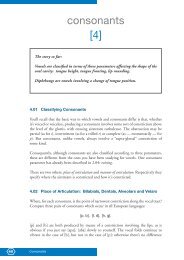PHONETICS MANUAL.indd - HumBox
PHONETICS MANUAL.indd - HumBox
PHONETICS MANUAL.indd - HumBox
Create successful ePaper yourself
Turn your PDF publications into a flip-book with our unique Google optimized e-Paper software.
. THE UPPER FRONT TEETH. These are involved for example in the<br />
production of [T] and [ð] (as in thin and this), for which the tongue comes into contact<br />
with the back of the teeth. As the tongue is the moveable organ which initiates the<br />
contact, it is said to be an active articulator, and the teeth, which don’t move, are a<br />
passive articulator. The lower teeth and the remaining upper teeth don’t appear to have<br />
any role in language.<br />
c. THE ALVEOLAR RIDGE. Place the tip of your tongue against the rear of<br />
your upper front teeth. Then draw it slowly backwards along the roof of the mouth.<br />
You’ll notice that there is a bulge or ridge just behind the teeth, after which the<br />
roof of the mouth rises in quite a steep, domelike way. This is the teethridge — in<br />
phonetics more commonly called the alveolar ridge or alveolum. It’s an important<br />
passive articulator for sounds like [t], [d], [s] or [z]. Again the tongue is the active<br />
articulator.<br />
d. THE HARD PALATE. This is the steeply rising section of the roof of the<br />
mouth behind the alveolar ridge. It serves as a passive articulator in sounds like the h<br />
of huge.<br />
e. THE SOFT PALATE or VELUM. If you continue to run your tongue<br />
backward along the roof of the mouth (as far back as it can go) you will come to a<br />
point where the hard bone of the palate gives way to soft tissue. This section of the roof<br />
of the mouth is accordingly known as the soft palate, or, more commonly, the velum.<br />
The back of the tongue comes into contact with the velum for consonants like [k] and<br />
[g].<br />
The velum is an important organ of speech because it’s moveable and its movement<br />
controls the entrance to the nasal cavity. (That’s why it’s soft not hard: it consists<br />
of muscle tissue.) Raising the velum so that it’s pressed against the rear wall of the<br />
throat has the effect of closing off the nasal tract, so that air is diverted into the mouth<br />
(dashed line in Fig. 6). If you want to breathe through your nose, you have to lower<br />
the velum (solid line in Fig. 6).<br />
Nasal consonants like [m] or [n] and nasalized vowels are articulated with the velum<br />
lowered. For non-nasal sounds (that’s the vast majority), the velum must be in the<br />
raised position, so that the airstream passes into the mouth. Note that the velum can’t<br />
block the entrance to the oral cavity, even when it’s lowered. So even for nasal sounds,<br />
some air enters the mouth. More about this point in 3.08 and 4.09.<br />
f. THE UVULA. This is the extreme tip of the velum, and isn’t directly involved<br />
in the closure of the nasal cavity: you can see from Fig. 6 and several of the other figures<br />
how it dangles down instead of being pressed against the rear wall. Some r sounds in<br />
French and German involve the uvula. More about these in 4.11.<br />
10 The Vocal Tract






